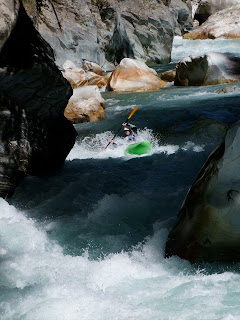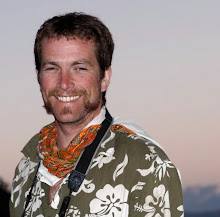

Photo's to follow...!!!
Bagirathi River.
The Bagirathi River is joined by many tributaries to form the Ganges River, which is the holiest river in India. The Bagirathi emerges from the Gaumukh (Cow’s Mouth) on the Gangotri Glacier. Unfortunately, a large hydro dam was built 3 years ago, which has flooded a huge section of presumably good whitewater. The Theri dam is the largest dam in India, and has displaced thousands of people. It holds enough water that that if it were to break, the entire city of Delhi would be destroyed. Upstream of the dam the river is big and steep.
We did our grocery shopping in a small dusty town, and luckily found a shop called “the English Wine Shop”. Since we had not touched alcohol for a week, we grabbed a 12 pack of the best beer (the only beer) they had to offer. 8% alcohol, syrupy sweet, and it comes in 1 litre bottles. It didn’t take long to polish the case off, and it seemed only right to break into the last bottle of duty free. A bottle of Tequila later, we were merrily rocking it out to loud Hindi music, cruising through the mountains, blissfully unaware of the dangers of the fragile road, broken and narrow, with crazy drivers in big trucks.
We woke next to the river (and road) with slightly fuzzy heads, loaded the van and drove up the valley looking for a put-in. The river section we were passing looked just perfect. Large volume, and continuous. Big, bouncy class 3-4 with long wave trains and great looking play spots. Exactly what the Doctor ordered!
We found a put in at a bridge, which crossed the river in the middle of an amazing looking class 4+ rapid. We just couldn’t wait to get on the water.
Once we put on we realised that the river was much pushier than we had thought! The waves were much bigger and the holes much scarier than they had looked from the road…Mostly still read and run-able, but powerful and fast, with boils and whirlies, exploding waves and haystacks. Hangovers were gone instantly in the crisp, cold, glacial melt water.
The river is wide, and busy. Early on in the trip I accidentally dropped into a hole that I thought was going to give me the thrashing of my life, but fortunately I simply melted down under it and resurfaced 5m meters downstream of it, with enough time to put 2 or 3 paddle strokes in to avoid another monster hole. Some of the others had seen this happen, so took a long, hard look at the rapid before running it. All got sweet lines and made it look easy! I learned my lesson and took a much more cautious approach for the rest of the day.
The whitewater was excellent. Very continuous, and powerful. No portaging and some of the best water that most of us had ever been on. The Bagirathi is a must do trip for any class 4 and 5 kayakers who visit this area of India.  As the Bagirathi is the source of the Ganges, there are many small temples and shrines here.
As the Bagirathi is the source of the Ganges, there are many small temples and shrines here. 
As with the other valleys we had been in, the Bagirathi has been ravaged by landslides this year. We passed through a small town that had lost quite a few buildings, and witnessed some amazing feats of road building over extremely unstable, often actively moving landslides. We were all far more terrified of the driving than the whitewater!
 With no other safe option we camped under a cliff that looked less likely to collapse than the landslide debris, on small ledge where we found enough wood to light a fire. Our Van driver chose the spot to light the fire with care-a pool of tar, that quickly lit and added some great fuel to the scarce wood!
With no other safe option we camped under a cliff that looked less likely to collapse than the landslide debris, on small ledge where we found enough wood to light a fire. Our Van driver chose the spot to light the fire with care-a pool of tar, that quickly lit and added some great fuel to the scarce wood!
In the morning, we drove further up the valley, in search of more whitewater. After paying off the Police, we found that the whitewater was a bit too crazy for us, and at the same time we realised that the road was getting too dangerous too. We turned around and headed back down the valley pleased to have escaped without falling off the road. We chose a section of river that looked a little juicier than the previous day’s section, and arranged to meet Laxman about 6km downstream at the site of another large landslide.  This section turned out to be a very similar style of paddling to the previous days, with a couple of huge rapids with big lines and big holes.
This section turned out to be a very similar style of paddling to the previous days, with a couple of huge rapids with big lines and big holes. 

 We had done 2 sections- from Helgi to Pala, and from Bhatwari to just upstream of Maneri, and left the valley feeling energised and excited, although a little concerned for the future of the river as the signs of the Uttarakand Hydro-electric Company were everywhere.
We had done 2 sections- from Helgi to Pala, and from Bhatwari to just upstream of Maneri, and left the valley feeling energised and excited, although a little concerned for the future of the river as the signs of the Uttarakand Hydro-electric Company were everywhere.
Seemingly, our driver was scared off by the Bagirathi driving and bailed on us. He was replaced by another, who lacked the dynamism of the original. He fell asleep at the wheel within an hour of picking us up and crashed into an oncoming vehicle (luckily we didn’t end up in the Thieri Dam). He got a bit of a slapping from the driver of the other vehicle, until JJ stepped in and calmed the situation down. JJ then took over the driving!
The next Valley to the East is the Alaknanda, which is where Shalab, India’s most famous whitewater kayaker lives. Shalab had organised our vehicle and driver and is also Laxman’s boss. He owns a little piece of Heaven on the bank of the Alaknanda, near Rudraprayag, where visiting kayakers and other tourists can escape from the madness of India and relax in luxury. We bee lined it to Shalab’s place!
See www.kayakindia.com for Shalab’s place!
Shalab gave us a good rundown of the runs to do and the runs that need to be done. We headed up the Mandakini, which is the biggest tributary of the Alaknanda, to do a deep gorge that Shalab had run in the past, plus a 6km steeper section above that had not yet been paddled. In total this would be a 26km run with a total elevation loss of about 550m.
We arrived at our put, just downstream of Sonprayag and began sorting gear for an overnight. We were quickly approache by the local dam construction workers who brought it to our attention that the river had been diverted into a tunnel, just around the corner from where our gear explosion was progressing.
The dam was in the early stages of construction, and every drop of water was diverted away, leaving a completely dry river bed for us to portage through, for the first half km or so of the trip. A weird beginning to a great trip.
The gorge we had dropped into was steep and boulder choked. We portaged quite a bit, but also ran some great drops and enjoyed the remoteness of the gorge-away from the dust and noise of the roads.

 The gradient slackened off a little, and we began looking for a camp spot. Lemurs ran through the trees, and kingfishers flew overhead. After exploring a few terrible looking camp sites, we stumbled upon a riverside cricket pitch, which was presumably the only flat spot for miles around, so the local kids had set it up as a cricket field.
The gradient slackened off a little, and we began looking for a camp spot. Lemurs ran through the trees, and kingfishers flew overhead. After exploring a few terrible looking camp sites, we stumbled upon a riverside cricket pitch, which was presumably the only flat spot for miles around, so the local kids had set it up as a cricket field.  They greeted us with loud shouts of “Welcome to India!”, “What’s your name?!”, etc. and after losing their cricket ball, decided that it way more fun to play with the kayaker’s gear!
They greeted us with loud shouts of “Welcome to India!”, “What’s your name?!”, etc. and after losing their cricket ball, decided that it way more fun to play with the kayaker’s gear!
The kids left before dark and we enjoyed the well cared-for grass and flat sleep spots, cooked up some rice and dahl for tea, and slept like babies. Breakfast was done quickly and we put on the river around 9.30.  The Mandakini grew in volume and the gradient stabilised to produce some excellent read and run (blind bomb) class 4 with a few class 5’s thrown in for good measure. The water remained interesting and enjoyable for the entire day with only 1 portage (Coop, Toby and Will ran everything).
The Mandakini grew in volume and the gradient stabilised to produce some excellent read and run (blind bomb) class 4 with a few class 5’s thrown in for good measure. The water remained interesting and enjoyable for the entire day with only 1 portage (Coop, Toby and Will ran everything).
We reached our take-out at Kund Chatti weary and hungry, but charged by such a good trip. Unfortunately, this was most likely the last descent of the upper Mandakini, as the dam will be complete later this year and the river will be gone for ever.

 Photo: Zak Shaw
Photo: Zak Shaw





















































